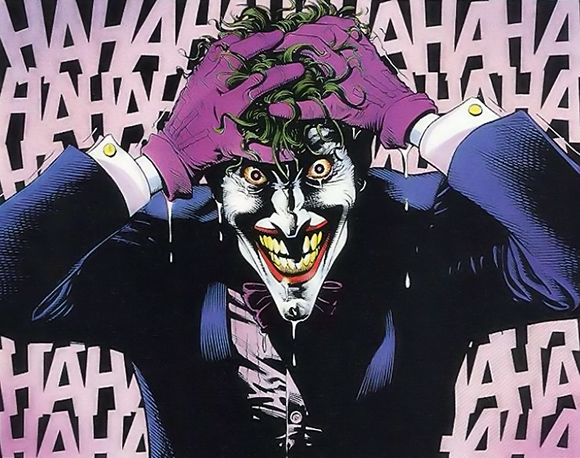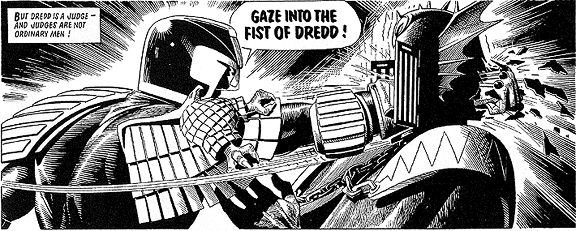Part 1 of this fine article can be found HERE!
Bolland was one of the very first comic creators ‘discovered’ by the American comic industry, spearheading the ‘British Invasion’ of ’79/’80. Joe Staton (co-creator of the Omega Men in Green Lantern and long standing DC illustrator) came to live with the Bollands to continue working on Green Lantern while attending a comic convention. Finding out that Bolland wasa Green Lantern fan, Staton called his editor, Jack Harris and said Bolland would like to draw a GL cover. Green Lantern 127 duly featured the work of a certain Mr B Bolland and the cross over the Atlantic was underway. A ‘trickle’ of covers began however Bolland would design covers that writers would craft stories from including Starro and the Superman Beastman cover (Superman 422 (Aug, 1986)).

Among his earliest interior work with DC was a short chapter in Justice League of America 200 – in which his work sat beside some industry legends – and some artistic heroes – Joe Kubert, Carmine Infantino and Gil Kane as the best of the best George Perez, Jim Apero and Dick Giordano. His success with GL 127 had opened the floodgates and following that small start American companies began to look to the small grey island on the far side of the Atlantic for fresh talent – in particular the heavily DC influenced artists of 2000AD. From Brian Bolland – aided in completing some of his works by his UK compatriots could now return the favour – by opening the door ajar enough for the big companies (namely DC offer Dave Gibbons, Kevin O’ Neill… Alan Davis, Mark Farmer and following the artists, Alan Grant ‘went across’ and at some point ‘a certain tall hairy writer from the Midlands.’ The British Invasion had begun and continues to rumble on. A spearhead created by the modest and extremely talented Brian Bolland, an enthusiast of comics he had now opened the door to for so many.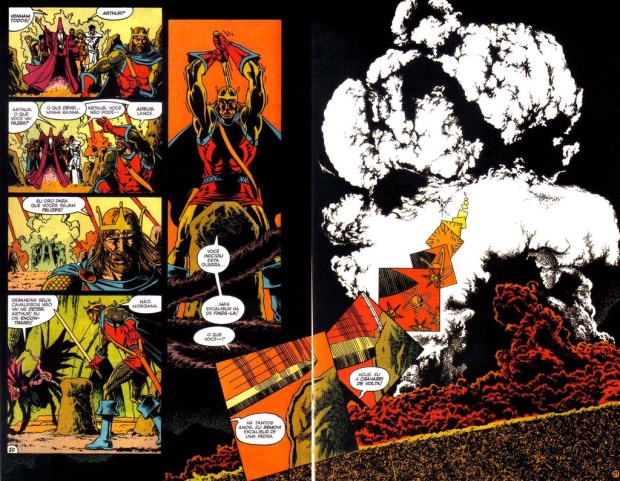
Len Wein, DC Editor in 1982 chose Bolland to be the artist of Camelot 3000, in which King Arthur returns from Legend to defend Britain from alien invasion. From this, Bolland enjoyed ‘being made a fuss of’ being flown to San Diego to represent DC and the sideways glance at the Arthurian Legends. His attempts to ignore the Andru drafted covers handed to him met with consternation from Wein and so Bolland conceded but reversed the ‘N’ in his name to remind him of his artistic integrity in indignant protest. The ‘N’ remains to this day, reversed as Bolland found he really liked it. 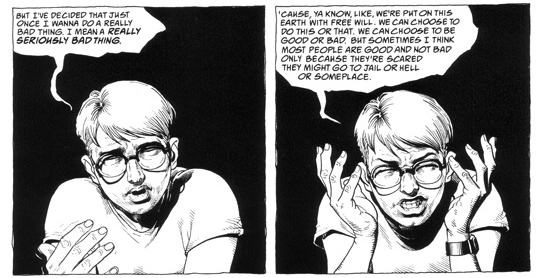
Others inked it (initially an irksome scenario to the practiced draftsman in Bolland though he eventually like the results.) Although the first example of a Maxi-series (12 issues), Camelot 3000 was monthly but Bolland struggled to get it out in time, representing the single largest body of work ever created by Bolland. His determination to make each page better and better and his intention to make the artwork in the final editions ‘look amazing’ caused issues 8-11 to go out quarterly instead of monthly, and the final issue cover dated nine months later than the penultimate issue. Camelot 3000 remains a noteworthy work of illuminated detail and careful and precise artwork attached to a great sci-fi story. 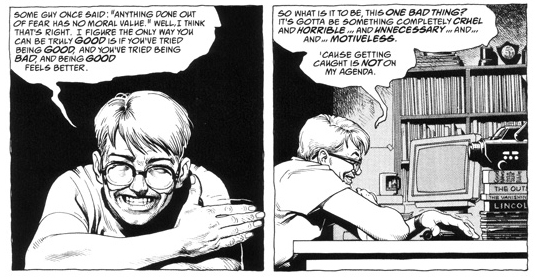
At the time Alan Moore was looking to work on a series under DC, talks underway for a crossover with the Dark Knight and Judge Dredd (which occurred some time later) featuring Bolland and Moore. Dc Editor Dick Giordano asked Bolland what project he wanted to work on next. Of this, Bolland says;
“I thought about it in terms of who’s my favourite writer at the moment, what hero I would really love to do, and which villain? I basically came up with Alan, Batman and the Joker.”
Batman: The Killing Joke was born in that moment. Bolland had a fascnation with the Joker, having recently watched the silent movie ‘The Man who Laughs’ and wanted to do a ‘Joker story with the Batman as a more distant, peripheral character.’ The result introduced one ‘possible origin story’ for the Joker and the plot required the sign off of a major character in the Batman canon being horrifically mutilated at the hands of the Joker. Controversial, incredibly influential and wildly popular The Killing Joke may never have happened. Moore was already at odds with DC following the completion of the Watchmen series (with Dave Gibbons) and effectively finished the job for his friend Bolland. With its near completion in 1988 after a considerable time working on it (both creators reknowned for their intricate and unswerving loyalty to accuracy and precision in ink), Bolland was afeared that it would be consumed by the media fire storm surrounding Frank Miller’s ground breaking Dark Knight Returns. He was also hurt when Moore referred to Killing Joke as ‘to him, just another Bat comic.’ Reeling from the statement by his friend regarding a title he held so close to his heart he was again mortified with the presentation of Watchmen colourist John Higgin’s finishes. Having imagined the flashback scenes in black and white he found “garish… hideous glowing purples and pinks… and my precious Eraserhead-esque flashback sequences swamped in orange.”
In 2008 a version was rereleased as a 20th Anniversary edition featuring colouring by Bolland, restoring his artistic intentions to the palate.
Unable to hand work over to other practitioners, and since Killing Joke, Bolland no longer drew any strip that was not penned by him. Disappointed by a masterpiece that took the comics world by storm rather than being overshadowed by the sharper and more muscular Dark Knight of the same period seems an odd response but a true artist has vision and Bolland can certainly be argued to be a true artist.
He wrote and drew ‘ An Innocent Guy’ for the Anthology title in 1996 in which an otherwise normal inhabitant of Gotham plans the ultimate crime: The murder of the Batman. In it he explored idea that nobody could be deemed a GOODIE or a BADDIE but walked a tightrope in between. Bolland created the covers for Gotham Knights 2-47 (from 5 coloured by himself). Eventually Bolland was told he’d be ‘off the book in a few issues time’ but upon discovering that upcoming covers featured Bane and not Penguin or the Joker as he’d been hoping for some time, Bolland said he’d go right away.
In the following years Bolland created covers for some of the most recognisable characters in DC, including 63 issues of Animal Man, covering the tenure of Grant Morrison, Peter Milligan, Tom Veitch and Jamie Delano. His practice of identifying a scene in the comic and then a hook from it that would create an entertaining cover has informed his work throughout.
He worked on The Invisibles (Grant Morrison), deftly dealing with the surrealism of the work (perhaps informed by his 60s college days…), and introducing the countdown numbers 12-1 to count down to the millennium installed, hidden into the cover image in each case after watching Peter Greenaway’s film ‘Counting by Numbers.’ By request he gained cover work on Wonder Woman (as she wasn’t interesting to A-List artists – Bolland not considering himself A-List), as well as Geoff John’s The Flash, Tank Girl, Superman, Green Lantern, Batman and Fables and Jack of Fables, Doom Patrol (though he was often rejected while trying to follow previous cover artist Simon Bisley’s work.)
He has produced odd covers for First Comics, Continuity Comics, Eclipse Comics and New Comics though admits a mild phobia about Marvel comics covers after a bad experience on a Marvel Uk Hulk cover and a She-Hulk cover featuring Howard the Duck. The latter is hard to imagine; even in Bolland’s accurate and realistic style.

He has since drawn (and written) Mr Mamoulian, a Robert Crumb-esque semi-autobiographical stream of conciousness humour strip and The Actress and the Bishop, written in rhyming couplets and based on request work from 1985. Both our personal projects but both are of course beautifully realised.
Brian Bolland is a spearhead, notably well loved in his industry. A mainstay of the art form of comic books – Bolland has sold millions of comic books, revolutionised a long standing hero and worked with some of the most demanding and impressive minds in the comic industry. His work a matter of pride first, he has managed to enjoy a long and respected career in comics. His covers are memorable and indelible, as is the effect he has had on the readership throughout his long and impressive career.
But to me the greatest thing about Brian Bolland is that because of his realism and acute awareness to detail and pursuit of accuracy you would never know how old he is. Within his own lifetime, and beyond thanks to his work on Judge Dredd and Batman, with Moore, Morrison and… more. His work is timeless and will illustrate the accomplishments of a great many more artists and writers for many more years to come. Which is, perhaps, why he, more than perhaps all others, has represented so many others on the covers of such great titles.


